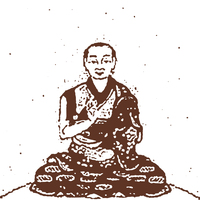
Detri Rinpoche
The Third Detri Rinpoche, Jamyang Thubten Nyima (sDe-khri ’Jam-dbyangs thub-bstan nyi-ma) was born to a family of Mongol heritage in 1779 in Tsezhung (rTse-gzhung), in the eastern Tibetan region of Amdo.
At the age of five, along with his family, he attended a public audience with the Second Jamyang Zhepa (’Jam-dbyangs bzhad-pa dKon-mchog ’jigs-med dbang-po), who noticed that he was crying. The boy stated that he was Detri, and after going through the traditional process for identifying reincarnated lamas, he was recognized as the third incarnation in the Detri lineage, the reincarnation of the Second Detri Rinpoche, Jigme Lungrig Gyatso (sDe-khri ’Jigs-med lung-rigs rgya-mtsho). The following year, the boy was enthroned at Labrang Monastery (Bla-brang dGon) in Amdo and given the name Jamyang Thubten Nyima.
For the next few years, he learned reading and writing and, from the age of nine, started to receive tantric empowerments. In 1793, he took the novice vows of a monk, and then in 1779, received full ordination from the Third Gungtang Rinpoche, Konchog Tenpe Dronme (Gung-thang-tsh dKon-mchog bstan-pa’i sgron-me). After this, he originally wished to go to Lhasa to further his studies, but he ended up in Wutai Shan in China, where he received teachings and initiations from the resident teachers. While there, he spent time in Beijing and also in Mongolia, where he founded Dolon Bulak Monastery (Do-lon Bu-lag dGon). After spending over a decade in northern China, he returned to Labrang, and after the Gungtang Rinpoche’s passing in 1822, he was made the throne-holder of the monastery.
Over the next few decades, Jamyang Thubten Nyima continued to travel between Amdo, Wutai Shan, Beijing, and Mongolia. He gave teachings in all of these places and became very well-known. His Presentation of the Generation Stage of Glorious Kalachakra: The Oral Tradition of Manjushri (dPal dus-kyi ’khor-lo’i bskyed-rim-gyi rnam-bzhag ’jam-dpal zhal-lung) has become the definitive text on the sadhana practice of Kalachakra in the Gelug tradition.
In 1858, he was given the esteemed title of Sertri (Ser-khri) or “Golden Throne Holder,” which was usually only bestowed upon lamas who had held positions in Lhasa, which he had never done. In 1862, he passed away at the age of 84.